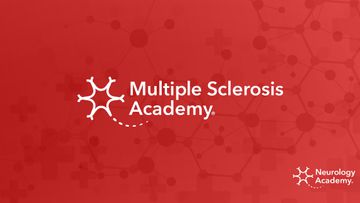Seeing a difference in neuromyelitis optica spectrum disorder: Integrating novel strategies into care
Event reportsLearning objectives included:
- Outline strategies for diagnosing NMO early and accurately
- how new treatments target NMO relapse
- phase 3 study results
- new treatments impacting current algorithm
Kazuo Fujihara discussed early diagnosis as essential for reducing the burden of disease. He also shared how essential it is to understand the differences between MS and NMO, highlighting that the disease-modifying treatments for MS can exacerbate NMO.
- Specifically fingolimod, natalizumab, alemtuzumab and interferon-beta can all have a detrimental effect.
- Current treatments include high dose steroids, azathioprine, mycophenolate mofatil, rituxumab, methotrexate.
- Three new treatment choices have just passed their phase 3 trials specifically for NMO: eculizumab, inebilizumab and satralizumab.
Details of what constitutes a core clinical diagnosis for NMO were outlined.
Patient should be positive for cell-based aquaporin 4 (AQP4)-lgG as well as having clinical characteristics such as:
- Optic neuritis
- acute myelitis
- area postrema syndrome
- acute brainstem syndrome
- narcolepsy / acute diencephalic clinical syndrome
- symptomatic cerebral syndrome
The differential diagnosis between MS and NMO was discussed, with the following shared are more likely to indicate an NMO diagnosis:
- spinal cord lesions are localised to AQP4 high-expression sites
- bright spotty lesions are more common
- spinal cord atrophy and acute transverse myelitis is more severe
- brain atrophy is less severe
- Longitudinal extensive transverse myelitis (LETM) is very uncommon in MS
Atypical findings or red flags shared included sarcoidosis as it can mimic NMO, and short spinal cord lesions; whilst relatively uncommon in NMO, Kazuo noted a recent Mayo Clinic study found 15% of new diagnoses had shorter lesions.
Kazuo went into detail regarding AQP4's role in a healthy brain, and it's function in someone with NMO. He also highlighted some of the other biomarkers to be aware of, including:
- Th17-related cytokines
- CXCL1, CXCL5 and CXCL7 in the cerebrol spinal fluid
- Glial fibrillary acidic protein (GFAP) and Neurofilament light polypeptides (NfL)
- Exosomal microRNAs
Kazuo ended by highlighting that reduced quality of life was another marker of NMO, with most patients having had an initial diagnosis other than NMO. He noted findings from Beekman, 2019 that a delayed diagnosis often had a strong negative impact on people's physical function, and the many people experienced:
- increased pain,
- bladder and bowel problems
- sexual dysfunction
- an inability to work.
Key references:
Yeo T, Probert F, Jurynczyk M, et al. 'Classifying the antibody-negative NMO syndromes: Clinical, imaging, and metabolomic modeling'. Neurol Neuroimmunol Neuroinflamm. 2019;6(6):e626. Published 2019 Oct 28. doi:10.1212/NXI.0000000000000626
Beekman J, Keisler A, Pedraza O, et al. Neuromyelitis optica spectrum disorder: Patient experience and quality of life. Neurol Neuroimmunol Neuroinflamm. 2019;6(4):e580. Published 2019 Jun 20. doi:10.1212/NXI.0000000000000580
Sean Pittock looked at treatment goals for those with NMO, stating that the rapid progression of NMO requires aggressive immunosuppressive therapy. He also shared that:
- traditional approaches using immunosuppression (steroids and azathioprine) or B-cell targeted therapy (rituximab) have not been proven at a phase 3 trial,
- 40-80% of patients will relapse at last follow-up using these therapies.
He presented the findings of the latest phase 3 trials for eculizumab (PREVENT), inebilizumab (N-MOmentum) and satralizumab (SAKura-Sky and SAKura-Star), detailing their results, and any adverse effects.
(MS Academy faculty members Rachel Dorsey-Campbell and Dr Wallace Brownlee also had an interesting conversation on the PREVENT and SAKura-Sky studies following the EAN conference earlier this year, for further information.)
Key references:
PREVENT:
Pittock SJ, Berthele A, Fujihara K, Kim HJ, Levy M, Palace J, Nakashima I, Terzi M, Totolyan N, Viswanathan S, Wang KC, Pace A, et al, 'Eculizumab in Aquaporin-4–Positive Neuromyelitis Optica Spectrum Disorder', N Engl J Med 2019; 381:614-625 DOI: 10.1056/NEJMoa1900866
N-MOmentum:
Cree BAC, Bennett JL, Kim HJ, Weinshenker BG, Pittock SJ, Wingerchuk DM, et al, 'Inebilizumab for the treatment of neuromyelitis optica spectrum disorder (N-MOmentum): a double-blind, randomised placebo-controlled phase 2/3 trial', The Lancet, September 05, 2019 DOI:https://doi.org/10.1016/S0140-6736(19)31817-3
SAKura-Sky and SAKura-Star:
Takashi Yamamura T, Kleiter I, Fujihara K, Palace J, Greenberg B, Zakrzewska-Pniewska B, Patt F, Tsai CP, Saiz A,Yamazaki H,et al:‘Trial of Satralizumab in Neuromyelitis Optica Spectrum Disorder’, November 28, 2019, N Engl J Med 2019; 381:2114-2124; DOI: 10.1056/NEJMoa1901747
The three presenters then discussed the treatment options for a fictional case study, both at present, and in considering these new treatments, looking at preferences, lifestyle, accessibility to services, and more.
Related articles
Encouraging excellence, developing leaders, inspiring change
MS Academy was established five years ago and in that time has accomplished a huge amount. The six different levels of specialist MS training are dedicated to case-based learning and practical application of cutting edge research. Home to national programme Raising the Bar and the fantastic workstream content it is producing, this is an exciting Academy to belong to.

